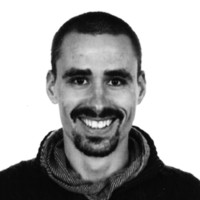Índice
Pueden descargar el código fuente de esta lección.
En este tutorial veremos como capturar y manejar eventos.
Un evento es simplemete algo que pasa. Como presionar una tecla, mover el ratón, redimensionar la ventana o cuando el usuario quiere cerrar la ventana.
//The headers
#include "SDL/SDL.h"
#include "SDL/SDL_image.h"
#include <string>
//Screen attributes
const int SCREEN_WIDTH = 640;
const int SCREEN_HEIGHT = 480;
const int SCREEN_BPP = 32;
//The surfaces
SDL_Surface *image = NULL;
SDL_Surface *screen = NULL;
Arriba tenemos lo que hemos ido aprendiendo hasta ahora, las cabeceras, constantes e imágenes.
//Variable de tipo evento, para posteriormente manejarlo.
SDL_Event event;
Una estructura SDL_Event almacena los datos del evento para que lo manejemos.
SDL_Surface *load_image( std::string filename )
{
//The image that's loaded
SDL_Surface* loadedImage = NULL;
//The optimized image that will be used
SDL_Surface* optimizedImage = NULL;
//Load the image
loadedImage = IMG_Load( filename.c_str() );
//If the image loaded
if( loadedImage != NULL )
{
//Create an optimized image
optimizedImage = SDL_DisplayFormat( loadedImage );
//Free the old image
SDL_FreeSurface( loadedImage );
}
//Return the optimized image
return optimizedImage;
}
void apply_surface( int x, int y, SDL_Surface* source, SDL_Surface* destination )
{
//Temporary rectangle to hold the offsets
SDL_Rect offset;
//Get the offsets
offset.x = x;
offset.y = y;
//Blit the surface
SDL_BlitSurface( source, NULL, destination, &offset; );
}
Nuestras funciones para cargar y fusionar las imágenes, no ha cambiado nada con respecto al tutorial 2.
bool init()
{
//Initialize all SDL subsystems
if( SDL_Init( SDL_INIT_EVERYTHING ) == -1 )
{
return false;
}
//Set up the screen
screen = SDL_SetVideoMode( SCREEN_WIDTH, SCREEN_HEIGHT, SCREEN_BPP, SDL_SWSURFACE );
//If there was an error in setting up the screen
if( screen == NULL )
{
return false;
}
//Set the window caption
SDL_WM_SetCaption( "Event test", NULL );
//If everything initialized fine
return true;
}
La función de inicialización, que inicializa SDL, configura la ventana fijando un título para la misma y devuelve false si ocurre algún error.
bool load_files()
{
//Load the image
image = load_image( "x.png" );
//If there was an error in loading the image
if( image == NULL )
{
return false;
}
//If everything loaded fine
return true;
}
Función para cargar la imagen. Devuelve false si ocurre algún error.
void clean_up()
{
//Free the image
SDL_FreeSurface( image );
//Quit SDL
SDL_Quit();
}
Función para borrar los datos de la memoria al terminar el programa.
int main( int argc, char* args[] )
{
//Make sure the program waits for a quit
bool quit = false;
Ésta es la función principal, donde creamos la variable que nos dirá cuando quiere el usuario cerrar la ventana. Al iniciar el programa, lógicamente la igualamos a false, ya que de lo contrario el programa finalizaría inmediatamente.
//Initialize
if( init() == false )
{
return 1;
}
//Load the files
if( load_files() == false )
{
return 1;
}
Llamamos a las funciones de inicialización y carga de imágenes que definimos anteriormente.
//Apply the surface to the screen
apply_surface( 0, 0, image, screen );
//Update the screen
if( SDL_Flip( screen ) == -1 )
{
return 1;
}
Con éste fragmento de código mostramos la imágen en pantalla.
//While the user hasn't quit
while( quit == false )
{
Comenzamos el bucle principal, el cual seguirá funcionando hasta que el usuario fije la variable quit a true.
//While there's an event to handle
while( SDL_PollEvent( &event; ) )
{
En SDL cuando ocurre un evento, se coloca en la cola de eventos. Ésta cola de eventos contiene los datos de los eventos para cada evento que sucede. Por ejemplo si fuera a presionar un botón del ratón, mover el cursor y a continuación, presionar una tecla del teclado, la cola de eventos se vería así:
Lo que SDL_PollEvent() hace es sacar un evento de la cola y guardar sus datos en nuestra estructura de tipo Evento:
Por lo tanto este código es recoger datos de los eventos mientras haya en la cola.
//If the user has Xed out the window
if( event.type == SDL_QUIT )
{
//Quit the program
quit = true;
}
}
}
Cuando el usuario clica en la X de la ventana, el tipo de evento que se genera es SDL_QUIT. Pero al hacer esto no implica que el programa termine, todo lo que hace este evento es informarnos que el usuario quiere salir del programa. Ahora que sabemos que el usuario quiere finalizar la ejecución del programa, asignamos el valor true a la variable quit, lo que romperá la ejecución del bucle while en el que nos encontramos.
//Free the surface and quit SDL
clean_up();
return 0;
}
Finalmente, llamamos a nuestra función clean_up() para que elimine las variables creadas por SDL.
Hay otras maneras de controlar eventos como SDL_WaitEvent() y SDL_PeepEvents(). Se puede encontrar más información sobre esto en la documentación de SDL.
Fuente:
Siguiente tema: Lección 5 - Colores Clave
¿Has visto algún error?: Por favor, ayúdame a corregirlo contactando conmigo o comentando abajo.
